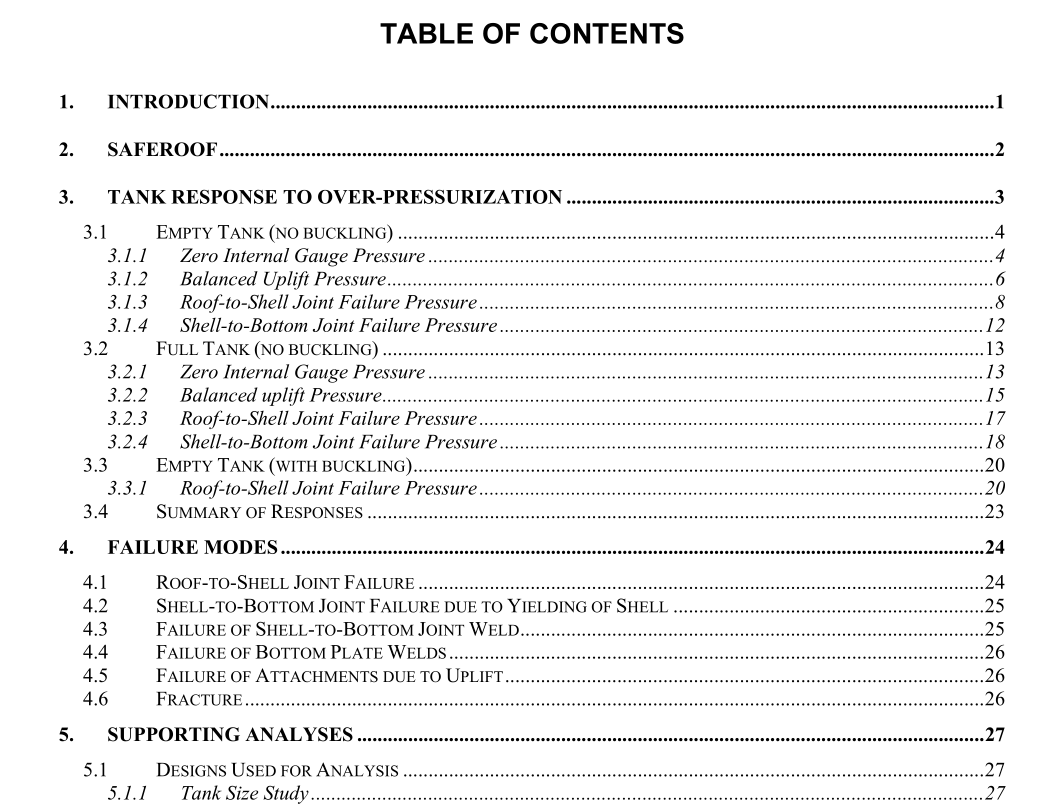API Publ 937-A pdf download

API Publ 937-A pdf download.Study to Establish Relations for the Relative Strength of API 650 Cone Roof Roof-to-Shell and Shell-to-Bottom Joints
2. SafeRoof
The calculations in this report were made using the SafeRoof computer program (Lu and Swenson, 1994). SafeRoof was developed to design and analyze storage tanks with frangible roof joints. The program is the result of a research program into frangible joint design, sponsored by the American Petroleum Institute and the Pressure Vessel Research Council. SafeRoof includes design, analysis, and post-processing modules. In the design module, the user can input tank parameters and SafeRoof will develop a design following API 650 guidelines. This design can either be accepted or modified. The user can then analyze the stresses and displacements in the tank at pressures corresponding to selected tank failure modes. The analysis can be coupled to a combustion/joint failure analysis. The pressures at each failure mode can be used to help evaluate safety of the tank due to overload pressures. The original version of SafeRoof used a static, large displacement, elastic finite element model. As part of this project, version 2.0 was extended to incorporate the capability to perform dynamic, large displacement, elastic-plastic analyses of tank response. This capability is based on the FMA-3D code (FMA, 2004). Version 2.1 includes the capability to approximate circumferential buckling in the roof and floor. Buckling is approximated by reducing the circumferential stiffness of the roof (or floor) finite elements by a factor of 10 in the elements in which compressive circumferential stresses are detected. Based on beam flange buckling practice, buckling effects are not included within a distance of 32 times the roof (or floor) thickness from the joint. In addition, for buckling of the floor, the floor must have uplifted from the supporting foundation.
3. Tank Response to Over-Pressurization
Before discussing the general results for the study, it is important to examine in detail the response of an oil storage tank to over-pressurization, based on previous work (Swenson et al., 1996). A tank with a 30 foot diameter and a 32 foot height will be discussed as a representative tank. The tank parameters are given in Figure 3-1.This design was done using the SafeRoof program (Lu and Swenson, 1994). This program follows API 650 rules to design the tank. The maximum fluid level is assumed to be 31 feet, with a specific gravity of 0.95. The material is ASTM A36, with a minimum yield strength of 36,000 psi, a modulus of 30E6 psi, and a Poisson’s ratio of 0.25. In this example, the minimum yield strength was used, however, the typical yield strength should be used for design calculations. The design has four courses with a thickness of 0.1875 inch. The top angle faces radially outward, with an angle width of 2 inches and a thickness of 0.1875 inches. The roof is welded to the top angle at a distance of 1 inch outside the radius of the tank. The slope of the roof is 0.75 inches in 12 inches. The bottom thickness is 0.25 inches. The tank is assumed to rest on sand, with a ringwall foundation. The stiffness of the sand is assumed to be 250 lb/sq. in/in and the stiffness of the foundation is assumed to be 1,000 lb/sq. in/in. The inner radius of the ringwall is 14.5 ft. The weight of the roof and tank shell is calculated to be 28,400 lbs. This does not include any deadweight due to stairways or other attachments. As will be discussed, the roof-to-shell and shell-to-bottom joints act in circumferential compression at their respective failure pressures. This can lead to circumferential buckling of the roof near the roof-to-shell joint. The same buckling can occur at the shell-to-bottom joint, although to a lesser extent. If buckling occurs, it reduces the participation of the roof in carrying the compressive load at the joint. This leads to a lower calculated failure pressure than if buckling is not taken into account. This will be discussed for the case of an empty tank.









